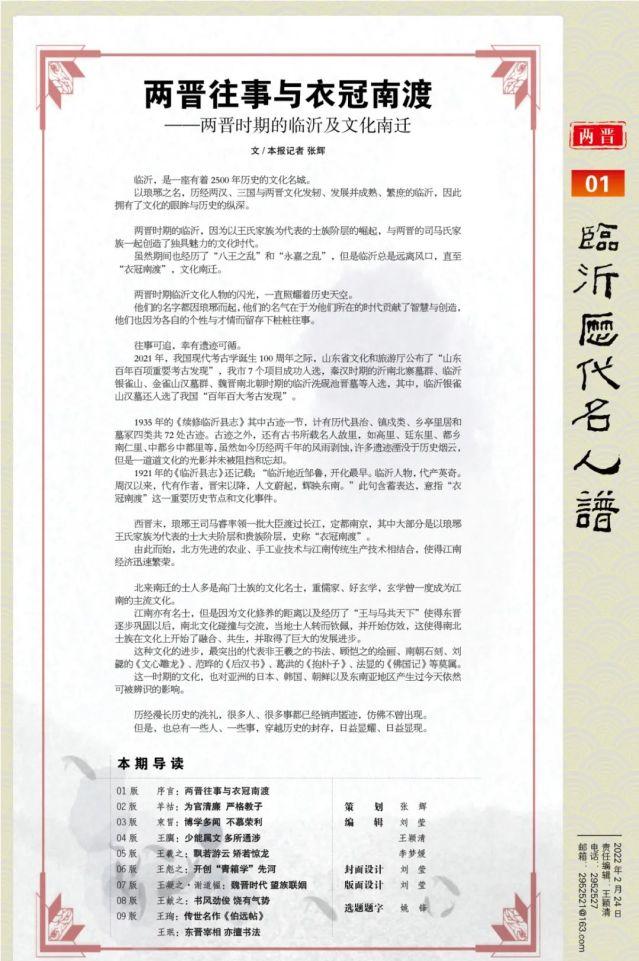Linyi is a famous cultural city with a history of 2500 years.
In the name of Langya, Linyi, which has experienced the development, development and maturity of the culture of the Two Han Dynasties, the Three Kingdoms and the Two Jin Dynasties, has the eyes of culture and the depth of history.
Linyi in the Two Jin Dynasties, because of the rise of the scholar class represented by the Wang family, together with the Sima family of the two Jin Dynasties, created a unique cultural era.
Although the "Rebellion of the Eight Kings" and the "Rebellion of Yongjia" were also experienced during this period, Linyi was always far away from the wind outlet, until the "Yiguan South Crossing" and the culture moved south.
The flashes of Linyi cultural figures in the two Jin Dynasties have always shone in the sky of history.
Their names are all derived from Langya, their fame lies in the wisdom and creation they contributed to their time, and they also retained the past because of their individuality and talent.
The past can be traced, fortunately there are relics to follow.
In 2021, on the occasion of the 100th anniversary of the birth of modern archaeology in the mainland, the Department of Culture and Tourism of Shandong Province announced the "Shandong Centennial 100 Important Archaeological Discoveries", and 7 projects in our city were successfully selected, including the YinanbeiZhai Tomb Group in the Qin and Han Dynasties, the Yinque Mountain in Linyi, the Han Tomb group in Jinqueshan, and the Linyi Wash yanchi Jin Tomb in the Wei and Jin Dynasties period, among which the Linyi Yinqueshan Han Tomb was also selected as the "Top 100 Archaeological Discoveries in a Hundred Years" in the mainland.
In the 1935 "Chronicle of The Continuation of Linyi County", there are 72 monuments in the section of monuments, including the county administration, the town shu category, the township pavilion and the tomb. In addition to the monuments, there are also the hometowns of famous people in ancient books, such as Gaoli, Tingdongli, Duxiang Nanrenli, Zhongdu Township Zhongduli, etc. Although many relics have been eroded by wind and rain for two thousand years, many relics have been obliterated in the smoke and clouds of history, but the light and shadow of culture have not been blocked and forgotten.
The 1921 "Linyi County Chronicle" also records: "Linyi is close to Zoulu, and the earliest civilization is the first." Linyi character, daisy-produced Yingqi. Since the Zhou and Han Dynasties, there have been authors in the generations, the Jin and Song dynasties, the rise of humanities, and the glory of the southeast. This sentence is implicitly expressed, which means the important historical node and cultural event of "crossing the south of the crown".
At the end of the Western Jin Dynasty, Sima Rui, the king of Langya, led a group of ministers across the Yangtze River to set the capital at Nanjing, most of which were represented by the Langya Wang family' class of scholars and aristocrats, known in history as "Yiguan Nandu".
From this point on, the combination of advanced agricultural and handicraft technology in the north and the traditional production technology in Jiangnan made Jiangnan's economy prosper rapidly.
Most of the scholars who moved from the north to the south were cultural celebrities of the Gaomen shi clan, emphasizing Confucianism and good metaphysics, which once became the mainstream culture of Jiangnan.
There are also famous scholars in Jiangnan, but because of the distance of cultural cultivation and the experience of "the king and the horse are in the world" so that the Eastern Jin Dynasty gradually consolidated, the collision and exchange of north-south culture, the local scholars turned to admiration and began to imitate, which made the southern and northern shi clans begin to integrate and coexist culturally, and made great progress in development.
The most prominent representatives of this cultural progress are Wang Xizhi's calligraphy, Gu Kaizhi's paintings, Southern Dynasty stone carvings, Liu Xun's "Wenxin Carved Dragon", Fan Ye's "Book of later Han", Ge Hong's "Baopuzi", And Fa Xian's "Record of the Buddha's Kingdom".
The culture of this period also had an impact on Japan, Korea, Korea, and Southeast Asia in Asia that are still recognizable today.
After the baptism of a long history, many people and many things have disappeared, as if they have never appeared.
However, there are always some people and things that have passed through the seal of history and become more and more prominent and more apparent.
